Scientifically verify the attractiveness of baseball "fastball" such as the reason why 110-mile (177 km / h) fastball is impossible

"To what extent does human sphere speed grow?" Is a story of a favorite discussion of baseball fans any time. However, in a certain scientific 'fastball' verification, the record which has been updating has reached the limit no longer, and it seems impossible for the fastball of 110 mph (about 177 km / h) per hour.
Why It's Almost Impossible to Throw a 110 MPH Fastball | WIRED - YouTube
"There are many baseball players and fans that" pitcher's "fastball (fastball)" is baseball's flower ".

Mr. Gonzales of WIRED's lobby is covering the mechanism of "fast ball" which is one such baseball charm.

Everyone feels attractive to fastballs, trying to throw a ball as fast as possible.

The reason is simple, because fast balls are hard to beat. Major League final of 40% batterTed Williams"To hit a fastball is one of the most difficult things in any sport."

The pitcher pursues a fast ball because it is difficult to hit a fast ball for a batter.

In recent years, the ball speed of the major league pitcher tends to rise. There were 18 pitchers throwing fastballs over 100 miles per hour (about 161 km / h) in 2008, totaling 196 balls of 100 miles or more fast balls were cast.

On the other hand, 40 people who threw 100 balls of fastballs in 2017, throwing 1007 miles of fast balls totaling 1017 balls.

"So, how far is the pitcher's ball speed going up? According to experts, 110 miles per hour (about 177 km / h) is impossible"

Baseball fans for many yearsBob FellerYaNolan RyanIt has been fascinated by the fastball of a rush speed ball pitcher like.

And if you say the current fastball king, the YankeesAlloris Chapman. We hold a world record of 105.1 miles per hour (about 169 km / h).

The average ball speed of Chapman's straight is 101 miles per hour (about 163 km / h), and in 2017 it recorded 345 fastballs over 100 miles. It is said to be the best fastball pitcher in the Major League.

Mr. Gonzales asked Glenn Frésig, authority on the research of pitching mechanism, about the elements necessary for a pitcher throwing a fastball over 100 miles.

Although high tallness is an important factor, it is not sufficient condition, Mr. Fraisig. It is not strange that a player of 6 feet tall (about 182 cm) throws a faster ball than a 6 foot 10 inch (about 208 cm) player.

Mr. Fraisig uses motion capture technology to study the mechanism by which a fast ball can be thrown.

Of course, if thrown in the ideal throwing form, not everyone can throw a 100-mile fastball.

"Neither you nor I can throw a 100-mph fastball, even if you practice a lot, your ball speed will be limited to 70 to 80 miles (about 113 to 129 km / h)"

"Another person will have a limit on the speed of the ball from 90 to 100 miles (about 145 to 161 km / h)"

"If you can throw in the correct form, you can only reach the limit level of that person."

Mr. Freight saw Gonzalez 's pitching form and pointed out that because the elbow' s flex is insufficient, he needs to raise the ball more and throw the knees down with a low posture.

Gonzalez's pitching which received advice.
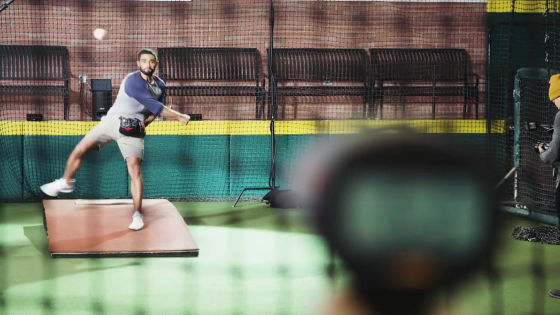
Still it is only about half as fast as the major league player.

Mr. Gonzalez asking about the limits of the human ball speed, "how fast the pitcher's ball speed extends?"

Mr. Freig thinks that the record of 105 mile (about 169 km / h) has already reached the limit.The average pitch speed of the pitcher is still going up, but it seems that many pitchers train muscular strength with training and optimal throwing method It will be possible to raise the ability to near his limit by mastering it. "
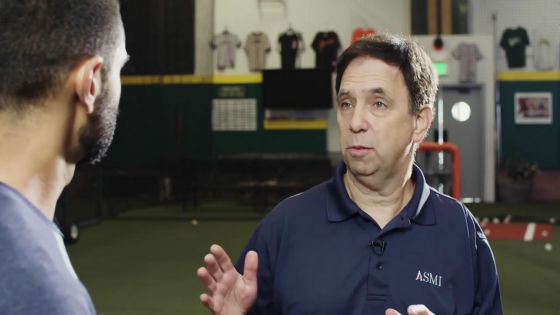
Fraig says that "injury" is one factor that imposes a limit on the pitcher's ball speed.

Throwing a fastball causes a heavy load on the elbow and shoulder. The load on the elbow by throwing a fastball is 100 Newton meters at maximum, which is equivalent to five 12-pound (about 5.4 kg) bowling balls.

Slight cracks may be generated in the ligament and tendon due to an intense load, and this crack expands to the extent that a fast ball is thrown. As a result of the ball speed of the pitcher rising,Tommy John SurgeryThere is a reality that the number of pitchers receiving a sharp increase.

It is a lot of fun to see the record grows steadily with other sports, but as far as pitching is concerned, Mr. Freig thinks he has reached the ceiling.

It is a fast ball that can shorten the player's life, but why is it that the pitcher is willing to throw the fast ball still?
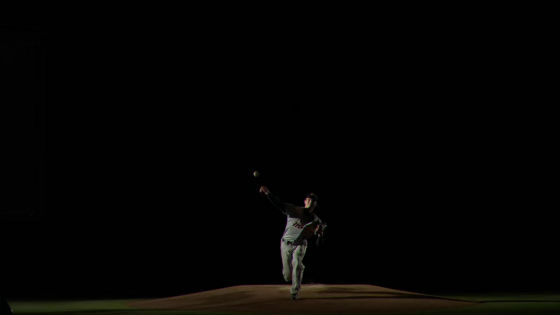
Because it is the royal road for the fastball to take the strikeout.

The distance from the pitcher's plate to the home plate, that is, the distance from the pitcher to the batter is determined to be 60.5 feet (about 18.4 m).

More precisely, the distance between the pitcher and the batter is a little short 55 feet (16.8 m) from the release point in front,

The time it takes for a fastball of 100 miles per hour (about 161 km / h) to travel is only 0.4 seconds.

Looking at the batter's position, it is necessary for 0.05 seconds to confirm the release of the pitcher's ball.

And it takes 0.15 seconds at the shortest including preliminary operation to spend time to shake the bat to meet.

In other words, the time allowed for a batter to judge whether to hit or not hit a 100-mile stiff ball is only 0.2 seconds. The faster the ball is, the shorter the time the batter can use for judgment, so the pitcher will increase the probability of striking the batter.
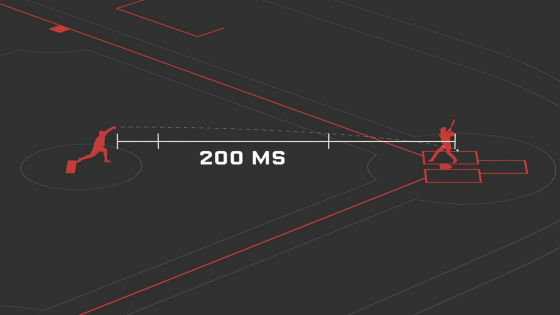
In order to experience how difficult it is actually to hit a fastball, Mr. Gonzales tried on a batter box.

Pitcher is a former major league, now Kevin Mulby, who is a pitcher coach at Villanova University.

It was very difficult to hit a former major league ball, resulting in only two scratches on the ball.

Mr. Marvie said he was unable to throw in the in-course for fear of the dead ball. Of course, if you get tired, the speed of the ball drops and mistakes increase.

However, a pitcher has also been created that does not make any mistakes and the ball speed does not change.

A virtual batting machine that reproduces pitchers on the screen is being developed at Viranova University.

In order to experience VR's rigid ball, Mr. Gonzalez puts a special goggle with motion capture function on the batter box.

In this virtual batting machine, you can change the ball types freely, such as straight, curve, slider, change-up and the ball speed can be changed from the high school level to the level exceeding major league, the screen is relatively inexpensive as $ 5000 (about 540,000 yen) And that.

When actually standing in the batter box, Mr. Gonzalez could not confirm the trajectory of the ball of the major league's pitcher.
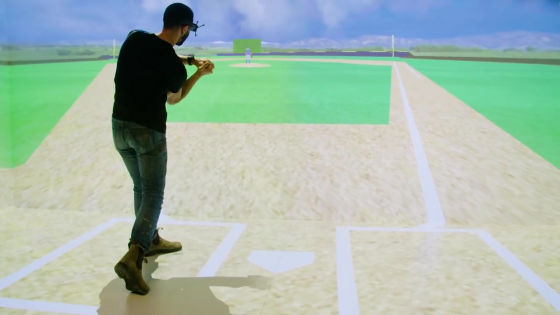
Dog Demalais who is a catcher in the baseball club of the University of Viranova can firmly determine the spherical muscles such as the ball type and the course.

Mark · Jupina, who developed a virtual batting machine. "Let's show you a ball of 120 miles (about 193 km / h)"

Mr. Gonzalez who challenges the ultra fast ball which impossible for a human being to throw is 120 miles.

When the ball was thrown in, it was only a bitter smile as "impossible".

Mr. Gonzalez who challenges another virtual batting machine developed by Mr. Jubina.

Attach the VR headset and stand on the batter box with the bat with the sensor in hand. On this machine it seems that you can hit the ball thrown in the virtual world.

I tried a quick ball that exceeded the human limit of 111 miles per hour (about 179 km / h) and succeeded in Justmates the 6th time.

Mr. Gonzales who looks very happy. With VR it is possible to experience a fastball that never happens in reality.

Mr. Freig, who appeared in the movie, said it was impossible to reach 110 miles (about 177 km / h), but expecting the appearance of a nonstandard superstar that betrays the expert's assumption is that baseball fans It may be sex.
Kaneda Shoichi Mr. Kaneda told reporters that the ball speed 180 km theory is "200 km?" │NEWS Post Seven
https://www.news-postseven.com/archives/20160116_377916.html

Related Posts:







